Introduction
The Thumb Controller by DJI (SZ DJI TECHNOLOGY CO., LTD), model RONIN TC1, is engineered as an essential accessory for filmmakers and videography professionals using the DJI Ronin and Ronin-M handheld gimbals. Designed for intuitive, single-handed operation, it allows users to precisely control pan, tilt, and roll axes, unlocking creative camera movements with ease. The compact form factor, pressure-sensitive stick, and crisp OLED display make it an indispensable tool for dynamic shoots.
With its FCC certification (FCC ID: SS3-800TC1512), the Thumb Controller meets stringent US regulations for radio frequency (RF) emissions and electromagnetic interference (EMI), ensuring both legal compliance and reliable performance in demanding environments. While the official FCC grant date is listed as ‘None’, the registration confirms that the device has undergone rigorous evaluation and is cleared for sale and operation in the United States.
This article delivers an in-depth look at the Thumb Controller’s key features, technical specifications, wireless technology, teardown insights from internal component images, and regulatory background—providing a comprehensive resource for both current and prospective Ronin users.
Key Features & Specifications
The DJI Thumb Controller (Model: RONIN TC1) is packed with features tailored for professional control and seamless gimbal operation. Below, we break down its primary functions and technical specifications, highlighting the practical benefits for users.
Key Features
- Selectable SmoothTrack Speeds (Fast, Normal, Slow):
- Enables users to match gimbal responsiveness to various shooting scenarios, from rapid action to slow, cinematic movements.
- Easy-to-Read OLED Display:
- 0.96-inch white OLED (128×64 dots) ensures clear, real-time feedback on settings and status, even in bright daylight.
- Sleep and Auto Power-Off Features:
- Prolongs battery life by automatically entering sleep mode or powering off after periods of inactivity.
- Quick-Release Accessory Mount:
- Easily attaches or detaches from compatible gimbals, streamlining setup and teardown.
- Wireless Communication:
- Built-in receiver enables cable-free control of the Ronin-M, reducing clutter and enhancing mobility.
- Pressure-Sensitive Stick:
- Offers granular, analog input for smooth and intuitive gimbal movement—ideal for precise framing and creative shots.
- Sleep and Power-Off Timers:
- User-configurable timers ensure the controller conserves power when not in use.
- SmoothTrack Speed Adjustment:
- Instantly switch between Fast, Normal, and Slow speed profiles to adapt to different filming needs.
Technical Specifications
- Operating Temperature: -20°C to 50°C
- Working Current: <100mA @ 3.3V
- Communication Distance: 60 meters (line of sight)
- Operating Frequency: 2.415GHz–2.473GHz
- Mounting Bracket Diameter: 1.0 inch or 1.2 inch (25 mm or 30 mm)
- Supported Devices: Ronin, Ronin-M
- Charge Time: 2 hours
- Battery Type: LiPo (Lithium Polymer)
Additional Extracted Specifications
- Bluetooth: Present (details not specified in available documentation)
- Battery:
- Type: LiPo
- Standby Life: 20 hours
- Active Battery Life: 18 hours
- Voltage: 3.7V
- Capacity: 1150mAh
Practical Benefits:
– Extended Battery Life: Up to 18 hours of operation ensures all-day shooting without frequent recharging.
– Long-Range Wireless Control: 60m communication distance lets operators work at significant distances from the gimbal, expanding creative possibilities.
– Rugged Design: Wide operating temperature range and robust build make it suitable for challenging field conditions.
– Universal Mounting: Adjustable bracket accommodates various gimbal handle sizes for broad compatibility.
Operating Frequencies
The DJI Thumb Controller (Model: RONIN TC1, FCC ID: SS3-800TC1512) operates within the following RF parameters, as specified in its FCC documentation:
| Frequency Range (GHz) | Output Power (mW) | FCC Rule Part |
|---|---|---|
| 2.415–2.473 | 5 | 15C/C2.1 |
These frequency bands and output power levels are crucial for ensuring robust wireless communication while maintaining compliance with FCC regulations. The 2.4GHz ISM band is widely used for short-range wireless devices such as Wi-Fi and Bluetooth, balancing range, throughput, and minimal interference for reliable gimbal control.
Technology Deep Dive
The Thumb Controller harnesses 2.4GHz wireless technology, a spectrum commonly leveraged by both Wi-Fi and Bluetooth protocols. While the equipment class and available documentation do not specify whether Wi-Fi or Bluetooth is exclusively used, the presence of Bluetooth and the 2.415–2.473GHz operating range confirm its alignment with standard ISM band communications.
Operating at 5mW output power, the controller is optimized for energy efficiency and reduced RF interference, supporting up to 60 meters of wireless range in open environments. This low-power approach not only conserves battery life but also ensures safe, interference-free operation alongside other wireless devices—a critical consideration on professional film sets.
The integration of a PCB antenna and advanced shielding (as revealed in teardown photos) underscores a design focused on signal integrity and EMI reduction. These engineering choices result in low-latency, highly reliable control, which is essential for real-time gimbal adjustments during complex shots. Power management circuits and sleep/auto-off features further enhance operational longevity, allowing filmmakers to focus on creativity rather than technical limitations.
In-Depth Internal Component Analysis / Teardown
Main PCB With RF Shielding and Power Subsystem
A close examination of the main PCB reveals a robust design philosophy centered on RF performance and reliability. The core of the board is obscured by a substantial metallic or graphite shield, a hallmark of high-quality wireless devices engineered to minimize electromagnetic interference. This shield likely conceals the main processor and RF circuitry, ensuring stable operation even in challenging environments. A coaxial cable routes to a PCB-mounted antenna, indicative of 2.4GHz wireless communication. The micro-USB connector at the base supports both charging and potential firmware updates, while directly soldered battery leads emphasize a secure, non-removable power solution. The overall layout, with its compact, multi-layer FR4 board, tactile controls, and integrated shielding, is consistent with the standards expected from DJI, promising both durability and high performance.
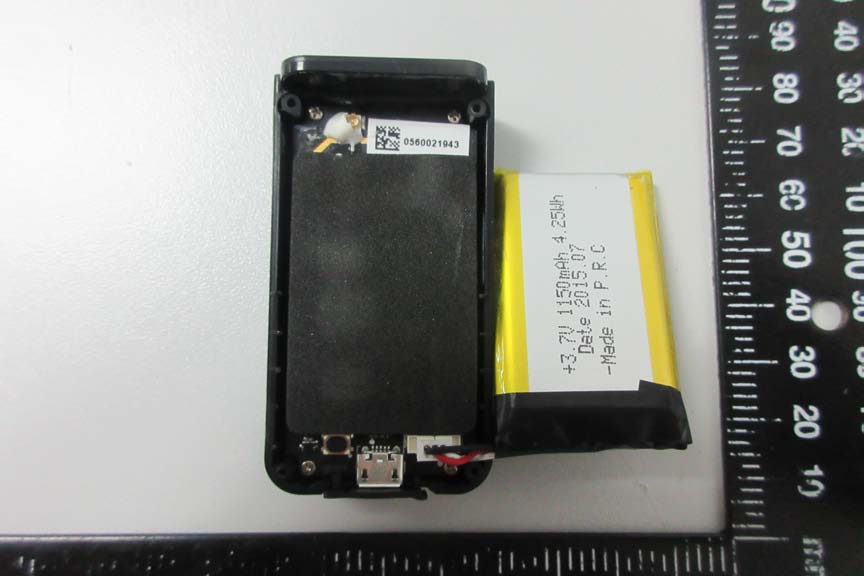
Exposed PCB With Integrated Antenna and Power Management
The internal architecture showcases a high-quality black PCB finished with ENIG plating, featuring a sophisticated layout optimized for RF signal integrity. Two major QFP/QFN ICs are present, with the central processor likely handling core logic and wireless communication. A distinctive gold-traced spiral confirms the presence of a PCB antenna, fine-tuned for 2.4GHz operation. Nearby, a micro-USB port and white FPC connector facilitate charging and display connectivity. Power regulation is managed by a combination of inductors and capacitors, supporting efficient battery charging and stable voltage delivery. The absence of metal shielding on this side is offset by careful ground pours and via stitching, effectively containing EMI. This layout reflects a meticulous balance between RF performance, power management, and manufacturability.
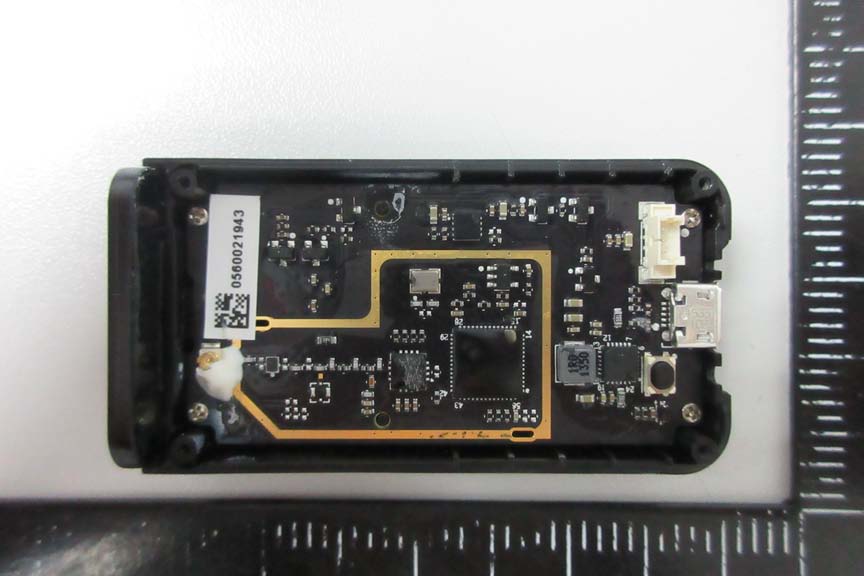
Display and Antenna Integration on Compact PCB
The controller’s user interface is realized through a compact OLED display connected via a flexible FPC, ensuring both durability and minimal thickness. The right side of the board features a large square spiral—most likely a PCB antenna tuned for 2.4GHz frequencies—integrated seamlessly to save space and maintain wireless performance. Numerous SMD components, test points, and gold-plated pads indicate a sophisticated approach to debugging and quality assurance. The black solder mask not only provides aesthetic appeal but also supports signal isolation. Ground via stitching around the antenna area further enhances EMI resilience. This design approach maximizes usability while preserving the compact form factor essential for handheld gimbal controllers.
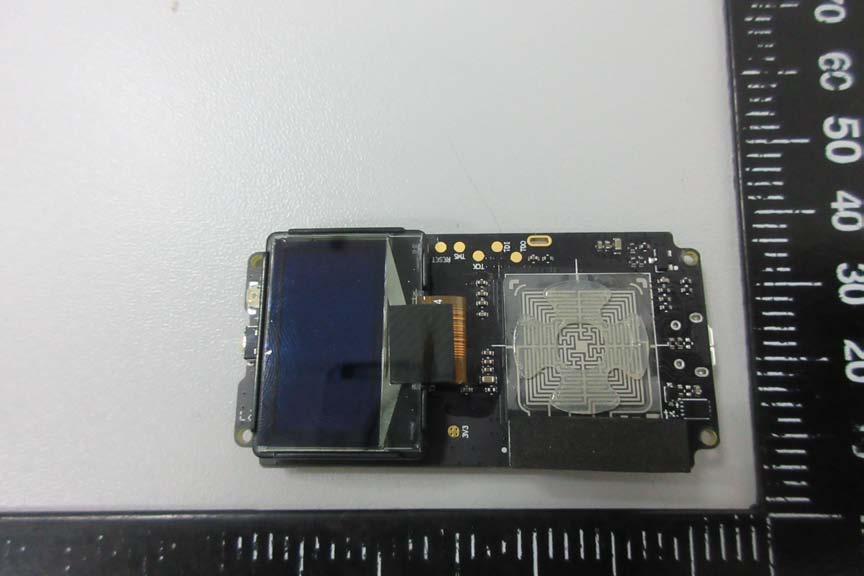
Shielded RF and Modular Display Connection
A prominent feature of this assembly is the large metal shield, meticulously soldered to the PCB to protect the sensitive RF and processing circuits beneath. The PCB itself is densely populated, with numerous vias and ground pours ensuring robust signal integrity. A meandered trace antenna, characteristic of 2.4GHz ISM band operation, is integrated directly onto the board, reflecting a cost-effective yet high-performance wireless design. The modular FPC connection to the display and potential edge connectors for peripherals emphasize a flexible, maintenance-friendly structure. Overall, the engineering prioritizes EMI control, modularity, and reliability, aligning perfectly with the demands of professional film production environments.
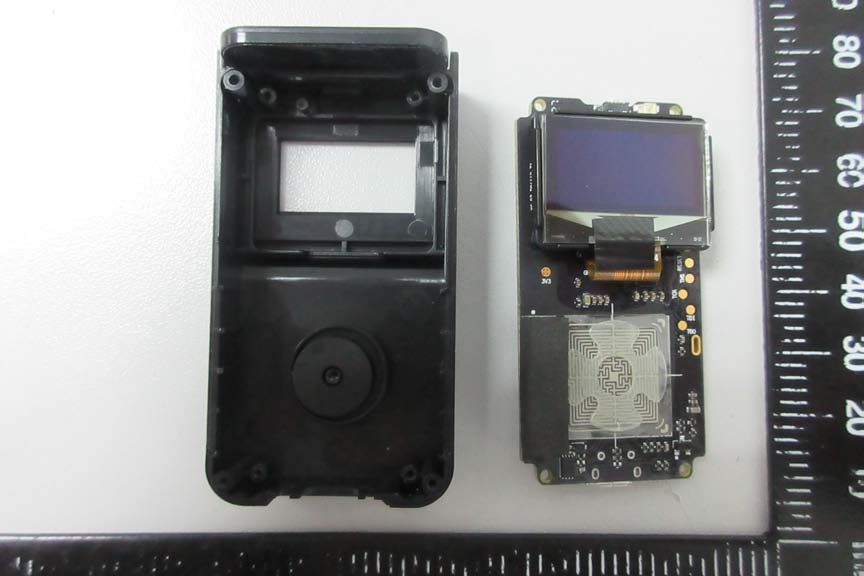
Core Controller ICs and RF Trace Architecture
At the heart of the board are two significant ICs: a likely main microcontroller or SoC and a secondary power management or interface IC. The gold-colored RF trace, meticulously routed with controlled impedance, terminates at a probable U.FL connector, hinting at provisions for external antenna attachment. The board’s black finish, extensive ground pours, and high component density highlight a premium build. Power regulation is handled by visible inductors and capacitors, supporting efficient battery operation. Additional features include a tactile button for controls, multiple crystals for clock signals, and numerous test points for diagnostics. This layout exemplifies DJI’s commitment to wireless performance, power efficiency, and ease of assembly.
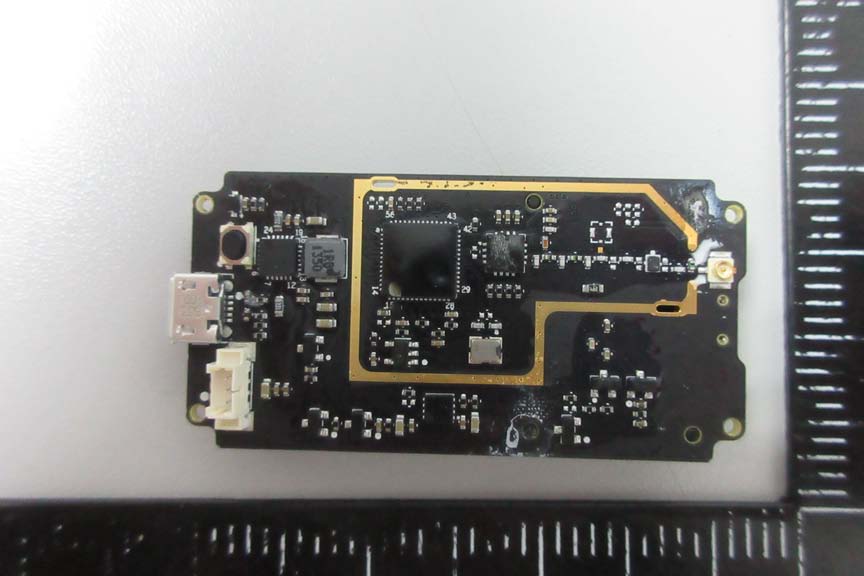
Regulatory Insights & FCC Filing
The FCC ID SS3-800TC1512 certifies that the DJI Thumb Controller complies with US standards for electromagnetic interference and RF emissions, making it legally eligible for sale and operation in the United States. Although the grant date is listed as ‘None’, the device is officially registered with the FCC, signifying that it has passed rigorous testing for radio emissions, susceptibility to interference, and user safety.
FCC filings typically include a wealth of technical documentation: RF exposure and emissions test reports, internal and external photographs, user manuals, block diagrams, and detailed schematics. These documents provide transparency into the device’s design and ensure that manufacturers adhere to strict regulatory limits—protecting both users and other electronic equipment from harmful interference.
According to the ‘Users-Manual-2905376.pdf’ summarized in the filing, the Thumb Controller is a purpose-built accessory for Ronin series gimbals, delivering pressure-sensitive, real-time control over pan, tilt, and roll axes. The inclusion of an OLED display and user-friendly interface underscores DJI’s commitment to both functionality and compliance. The FCC review process ensures that such wireless accessories deliver reliable performance without exceeding permissible RF output or causing disruptive interference.
Potential Use Cases & Target Audience
The DJI Thumb Controller is expressly designed for Ronin and Ronin-M handheld gimbal users, catering to a range of filmmaking and videography scenarios:
- Solo Cinematographers & Mobile Filmmakers: With its pressure-sensitive stick and compact form, operators can achieve smooth, single-handed control over complex gimbal movements—ideal for run-and-gun shooting, vlogging, or capturing dynamic action sequences without a dedicated camera crew.
- Professional Film Crews: On set, the Thumb Controller empowers camera assistants or focus pullers to wirelessly adjust gimbal orientation from up to 60 meters away, enabling precise coordination during multi-operator productions or when the gimbal is mounted on rigs, vehicles, or cranes.
- Event Videographers & Documentarians: The intuitive interface and long battery life make it well-suited for fast-paced environments, such as weddings, concerts, or live events, where quick, reliable adjustments are critical and downtime must be minimized.
In all cases, the combination of a tactile interface, OLED feedback, and robust wireless performance delivers enhanced creative control and operational efficiency.
Conclusion
The DJI Thumb Controller (Model: RONIN TC1, FCC ID: SS3-800TC1512) stands out as a meticulously engineered accessory, offering intuitive, precise, and reliable control for Ronin series gimbals. Its FCC certification underscores compliance with rigorous RF and EMI standards, ensuring both legal operation and interference-free performance. With its thoughtful blend of advanced wireless technology, user-centric features, and robust internal design, the Thumb Controller cements its position as a must-have tool for serious filmmakers and content creators seeking to elevate their creative workflow.